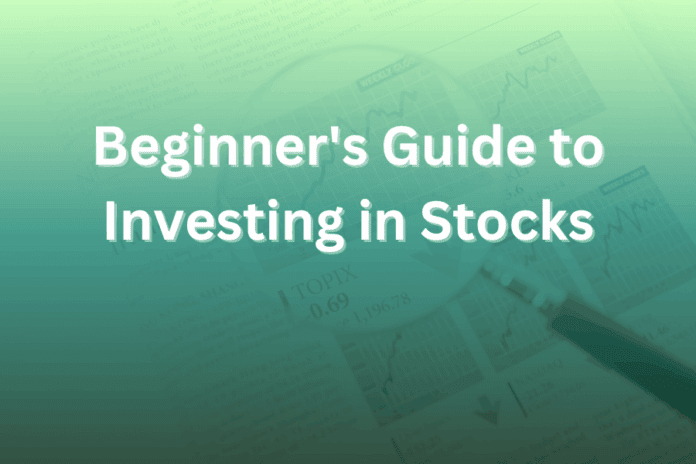Investing in stocks can feel intimidating when you’re just getting started, but you don’t need a finance degree or a large sum of money. You simply need a clear plan, some sound habits, and the willingness to learn.
In this article you will learn how the stock market works, how to pick your first investments, how to build a portfolio, manage risk and stay on track for your goals — all tailored for U.S. investors.
What Is the Stock Market and Why Invest?
When you buy shares of a company, you become a part-owner of that business. Stocks have historically delivered higher long-term returns than safe alternatives like savings accounts or bonds, though they also come with higher risk. Over decades, stock markets tend to move upward, offering a way to grow wealth if you stay invested long enough.
For someone in the U.S., investing in stocks can help you beat inflation, build retirement savings, pay for education, or simply grow your net worth. The key is to focus on the long term, rather than trying to “get rich quick.”
Set Your Foundation: Goals, Timeline, Risk Tolerance
Before you buy a single share, define your “why.” Are you investing for retirement in 30 years, a home purchase in 10 years, or building some extra income now? Your timeline influences how much risk you can afford to take. If you have decades until you need the money, you can lean into stocks. If you’ll need the cash soon, you’ll want to be more conservative.
Next, assess how you feel about risk. Can you sleep at night if your portfolio drops 20 %? If yes, you may handle stocks well. If not, you might prefer funds with some bond exposure.
Also make sure your emergency fund (3-6 months of living expenses) and high-interest debt are handled. Investing with money you can’t afford to lose is a recipe for stress and mistakes.
Choose the Right Investment Account
In the U.S., you’ll typically use one of these:
- A brokerage account (flexible, taxable).
- An IRA (tax-advantaged for retirement).
- Employer-sponsored 401(k) or similar.
Open an account with a trusted online broker or robo-advisor. Key criteria: low fees, good research/tools, user-friendly interface. Many brokers now offer commission-free stock and ETF trades, and fractional shares so you can start with small dollar amounts.
Build Your Investment Strategy
Now you decide how you’ll invest. Key choices:
- Will you pick stocks yourself, or use funds/ETFs?
- Will you go steady for decades, or trade often?
- What mix of stocks vs. bonds (asset allocation) fits your goals?
If you’re a total beginner, starting with diversified index funds or ETFs that hold a basket of stocks is smart. This gives you broad exposure and lowers company-specific risk. Then, later, you can add a few individual stocks if you want.
How to Pick Stocks or Funds
If you decide to invest in individual stocks, keep it simple: pick companies you understand and believe in. Look at fundamentals like earnings, revenue growth, debt levels and competitive advantage. Technical indicators (price trends, moving averages) may play a small role, but fundamentals matter most for long-term investors.
If you invest in funds or ETFs, check the expense ratio (lower is better), the fund’s holdings, and how well it tracks its benchmark. Remember diversified funds usually carry less risk than betting on a single stock.
Start Investing: Step by Step
- Open your account, link your bank, and fund the account.
- Decide your initial investment amount (you can start small).
- Choose your investment(s) and place your order. For stocks this might be a market or limit order.
- Invest regularly (monthly or quarterly) to build up steadily — known as dollar-cost averaging.
- Keep some cash or a short-term buffer so you don’t panic-sell when markets dip.
Diversification and Portfolio Maintenance
Diversification means spreading your money across many companies, sectors and maybe asset classes (stocks, bonds, real estate). This helps you avoid big losses when one company or sector suffers.
Over time, your portfolio may drift away from your target allocation (for example, stocks may grow and make you more aggressive than intended). Rebalance at least once a year: sell a bit of what’s grown too much, buy what’s lagging, to bring your portfolio back to target.
Understand Risk and Market Volatility
Stocks can swing up and down, sometimes violently. It can feel unsettling when your portfolio drops 10–20 % or more. But if you’re investing for the long term, you can use these dips as opportunities. Historical data show that markets tend to recover over several years.
Avoid attempting to time the market (buying at lows and selling at highs) – that strategy often fails. Instead, stay invested, stick to your plan, and don’t let emotions drive decisions.
Costs, Fees, and Tax Implications
Every dollar spent on fees is a dollar less working for you. Avoid high-cost mutual funds, frequent trading commissions, and subscriptions you don’t need. Opt for low-fee brokers and funds.
Be aware of tax consequences in your brokerage account: if you sell a stock for a gain, you may owe capital gains tax (short-term vs long-term rates differ). In tax-advantaged accounts (IRAs, 401(k)s), different rules apply. Understand them so you keep more of your returns.
Common Beginner Mistakes to Avoid
- Investing money you’ll need in the short-term.
- Focusing too much on “hot tips” or chasing trendy stocks.
- Neglecting diversification and concentration risk.
- Letting emotions (fear or greed) control your decisions.
- Ignoring fees and taxes.
- Changing strategies frequently (lack of discipline).
Monitor Progress and Stay the Course
Track your portfolio’s performance relative to your goals, not relative to your neighbor or the latest “meme stock.” Set periodic check-ins: quarterly or yearly. Make adjustments only when your goals or circumstances change.
With long-term goals, the most powerful force is compounding — earnings generate earnings. The earlier you start, the more you benefit. For example, even modest contributions over decades can grow substantially thanks to compound returns.
Action Plan for Beginners
- Define your goal and timeline.
- Save an emergency fund and pay off high-interest debt.
- Choose a brokerage/account type.
- Decide your asset allocation (e.g., 80% stocks, 20% bonds if 30 years to retirement).
- Start with low-cost diversified ETFs or index funds.
- Invest a set amount each month.
- Over time, learn and maybe pick one or two individual stocks if you like.
- Rebalance yearly, keep fees low, and ignore market noise.
Final Thoughts
Investing in stocks is one of the most effective ways to build wealth, but it’s not about quick wins or guessing the “next big thing.” Success comes from discipline, clarity of purpose, and a long-term mindset.
With prudent choices, consistency, and time on your side, you can navigate the markets, stay calm through ups and downs, and steadily put your money to work. Begin now, keep it simple, and let time become your ally.












